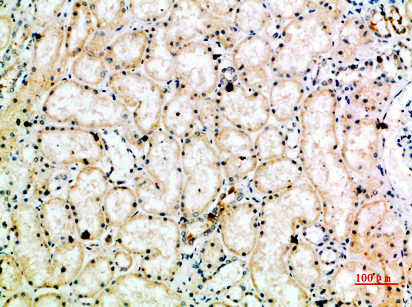HSP 75 Polyclonal Antibody
- Catalog No.:YT5990
- Applications:IHC;IF;ELISA
- Reactivity:Human;Rat;Mouse;
- Target:
- HSP 75
- Fields:
- >>Parkinson disease;>>Pathways of neurodegeneration - multiple diseases
- Gene Name:
- TRAP1 HSP75
- Protein Name:
- Heat shock protein 75 kDa, mitochondrial (HSP 75) (TNFR-associated protein 1) (Tumor necrosis factor type 1 receptor-associated protein) (TRAP-1)
- Human Gene Id:
- 10131
- Human Swiss Prot No:
- Q12931
- Mouse Gene Id:
- 68015
- Mouse Swiss Prot No:
- Q9CQN1
- Immunogen:
- The antiserum was produced against synthesized peptide derived from the Internal region of human TRAP1. AA range:481-530
- Specificity:
- The antibody detects endogenous HSP 75
- Formulation:
- Liquid in PBS containing 50% glycerol, 0.5% BSA and 0.02% sodium azide.
- Source:
- Polyclonal, Rabbit,IgG
- Dilution:
- IHC 1:50-200, ELISA 1:10000-20000. IF 1:50-200
- Purification:
- The antibody was affinity-purified from rabbit antiserum by affinity-chromatography using epitope-specific immunogen.
- Concentration:
- 1 mg/ml
- Storage Stability:
- -15°C to -25°C/1 year(Do not lower than -25°C)
- Other Name:
- Heat shock protein 75 kDa, mitochondrial (HSP 75;TNFR-associated protein 1;Tumor necrosis factor type 1 receptor-associated protein;TRAP-1)
- Background:
- This gene encodes a mitochondrial chaperone protein that is member of the heat shock protein 90 (HSP90) family. The encoded protein has ATPase activity and interacts with tumor necrosis factor type I. This protein may function in regulating cellular stress responses. Alternate splicing results in multiple transcript variants. [provided by RefSeq, Jan 2013],
- Function:
- function:Chaperone that expresses an ATPase activity.,similarity:Belongs to the heat shock protein 90 family.,subunit:Binds to the intracellular domain of tumor necrosis factor type 1 receptor. Binds to RB1.,tissue specificity:Found in skeletal muscle, liver, heart, brain, kidney, pancreas, lung and placenta.,
- Subcellular Location:
- Mitochondrion . Mitochondrion inner membrane . Mitochondrion matrix .
- Expression:
- Found in skeletal muscle, liver, heart, brain, kidney, pancreas, lung, placenta and bladder. Expression is highly reduced in bladder cancer and renal cell carcinoma specimens compared to healthy tissues, but it is increased in other type of tumors.
- June 19-2018
- WESTERN IMMUNOBLOTTING PROTOCOL
- June 19-2018
- IMMUNOHISTOCHEMISTRY-PARAFFIN PROTOCOL
- June 19-2018
- IMMUNOFLUORESCENCE PROTOCOL
- September 08-2020
- FLOW-CYTOMEYRT-PROTOCOL
- May 20-2022
- Cell-Based ELISA│解您多样本WB检测之困扰
- July 13-2018
- CELL-BASED-ELISA-PROTOCOL-FOR-ACETYL-PROTEIN
- July 13-2018
- CELL-BASED-ELISA-PROTOCOL-FOR-PHOSPHO-PROTEIN
- July 13-2018
- Antibody-FAQs
- Products Images

- Immunohistochemical analysis of paraffin-embedded human-kidney, antibody was diluted at 1:200



